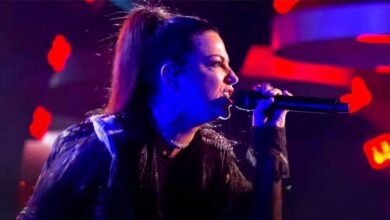Erik Grönwall Unveils a Stunningly Powerful Rendition of “House of the Rising Sun,” Leaving Devoted Fans of The Animals Completely Speechless
When Erik Grönwall, the former frontman of Skid Row, stepped away from the band to focus on his recovery from leukemia, many assumed his performing days might slow down. Instead, his return shattered all expectations. With his striking reinterpretation of The Animals’ 1964 classic “House of the Rising Sun,” he delivered one of the most powerful and emotionally charged covers in recent memory. Even fans devoted to the original admitted they were floored by his ability to modernize the track without losing its haunting soul or emotional core.
When Erik announced his “House of the Rising Sun (Epic Dark Version),” he set the stage for something extraordinary. The song begins with a haunting piano line that feels carved out of darkness itself—slow, deliberate, and gothic in tone. His voice emerges through that mist, smoky yet controlled, layered with deep emotion. Rather than rushing into the powerful highs most singers rely on, Erik leans into restraint, telling the story as if it were a confession whispered in a cathedral, letting every line carry quiet suspense before unleashing the storm.
In the early moments, he crafts a soundscape of tension and longing. Erik layers ethereal harmonies over his own lead vocals, forming a ghostly choral effect that feels both intimate and unsettling. Subtle organ tones hum beneath, like echoes from another century. As the song builds, the quiet eeriness gives way to an eruption of intensity—drums enter with precision, and Erik’s voice transforms into an unstoppable force, his powerful notes cutting through the mix like lightning over a stormy skyline. It’s a masterclass in musical control and dramatic release.
Just as listeners begin to settle into the dark tranquility, Erik turns the entire arrangement on its head. Suddenly, the song explodes into a wall of cinematic guitars, massive percussion, and choral harmonies that blend gothic majesty with modern metal energy. The transformation is breathtaking—the classic blues tragedy becomes a full-scale symphonic rock opera. Every ounce of his metal background surges through, yet the raw emotion of the original remains untouched, now wrapped in a new layer of grandeur and intensity that feels both ancient and futuristic.
Even those unfamiliar with metal found themselves captivated. The electric guitars don’t overpower—they enhance, adding weight and emotion like brushstrokes in a painting. Each riff feels intentional, echoing the song’s sense of danger and despair. The arrangement builds toward an enormous key change that feels almost sacred, his voice cutting through a halo of reverb and choral echoes. When he hits the final climactic notes, it’s as though the entire production becomes a cathedral of sound—grand, spiritual, and unforgettable—before collapsing into a bluesy whisper that carries a tinge of sorrow.
Just when the audience assumes the spectacle is over, Erik strips everything away. The heavy guitars fade into silence, leaving a minimalist piano melody that feels fragile, even haunted. Over this soft backdrop, he delivers a final verse in falsetto—tender, broken, and human. It’s a moment of vulnerability that contrasts sharply with the storm that came before. The result is stunning, like watching a sinner’s confession unfold after chaos. It’s a reminder that even the loudest hearts can break in silence, and that power doesn’t always mean volume.
In less than two months after release, the video surpassed 1.8 million views on YouTube—an astonishing number considering how many times “House of the Rising Sun” has been covered over the decades. The viral response made one thing clear: Erik had tapped into something timeless. He didn’t just reimagine the song; he revealed a new emotional layer that resonated with fans who’ve been singing it since the 1960s. He made it feel alive again, as though rediscovering a ghost that still had stories left to tell.
Comments flooded in from fans across generations, each one expressing disbelief at how deeply the performance hit them. People in their 60s and 70s—who grew up with The Animals’ version—wrote things like, “I’m 70 and this is the most moving rendition I’ve ever heard,” and “I never thought anyone could give me chills with this song again.” One fan wrote, “The original feels like a sepia photograph… this is 4K in color.” For once, nostalgia didn’t stand in the way of progress—it embraced it.
For many fans, the performance hit even harder knowing Erik’s personal journey. Having battled leukemia and undergone a bone marrow transplant just a few years prior, seeing him stand tall and sing with such strength was profoundly emotional. Cancer survivors and families left heartfelt comments, calling him a beacon of hope. One remark captured the collective feeling perfectly: “He sang it like a man who has lived every word.” That authenticity elevated the performance from artistry to testimony.
Erik’s delivery proves that technical perfection alone isn’t what moves people—it’s the emotion behind it. His version of “House of the Rising Sun” feels lived-in, weathered, and full of wisdom. He channels pain into melody, turning what could have been a simple cover into something deeply human. While his tone carries a metal singer’s power, it’s his storytelling that steals the spotlight. He reshapes the song into a theatrical narrative, balancing reverence for the original with fearless reinvention.
What’s fascinating is how Erik approaches the song like a storyteller retelling an old myth. He treats it as living folklore—malleable, haunting, and open to reinterpretation. The gothic piano, the layers of vocal harmonies, the bursts of cinematic production—all of it feels like a deliberate act of resurrection. He doesn’t just revive the melody; he breathes new life into the story of sin, loss, and redemption that has defined “House of the Rising Sun” for generations. In his hands, it becomes both prayer and warning.
Visually and emotionally, the video mirrors his current chapter in life. The dim lighting, gothic textures, and his commanding presence reflect not just aesthetic choices, but a metaphor for his journey—from darkness into recovery. There’s an honesty in his performance that can’t be staged. His voice carries the exhaustion of struggle and the triumph of survival in equal measure. It’s this truthfulness that makes the song linger in your chest long after it ends; you don’t just hear it—you feel it.
Beyond being a personal triumph, Erik’s interpretation challenges the boundaries of what a classic rock song can become. He proves that old hits aren’t relics to be preserved, but vessels that can evolve with time. By merging gothic metal and vintage blues, he demonstrates that emotion doesn’t belong to a single genre—it’s universal. His version invites artists everywhere to revisit classics with courage, to explore the past not as imitation but as inspiration for something entirely new.
By the time the final note fades, it’s clear that Erik Grönwall didn’t just cover “House of the Rising Sun”—he redefined it. His version captures the desperation and redemption buried within the lyrics and reflects it through his own story of survival. Every note feels like defiance, every whisper like rebirth. It’s the sound of a man who has faced death and chosen to sing louder. In doing so, he transformed an old song of ruin into a timeless anthem of resilience.





